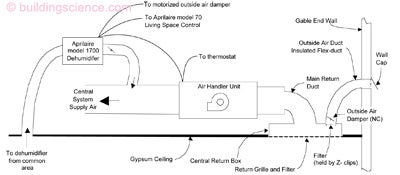High performance homes—due to superior insulation, better performing windows and more efficient lighting and appliances, can be expected to have smaller sensible cooling loads than typical new homes in the same geographic region. However, measures to improve the energy performance of the home generally do not affect internal humidity loads related to occupancy. Furthermore, under conditions where the moisture content of exterior air is higher than that of interior air—a condition that occurs for a significant portion of hours in hot and humid climates—dilution ventilation has the effect of increasing moisture levels within the building. The result is that latent cooling loads (the energy required to cool/remove moisture in the air) will typically be higher than sensible cooling loads for high-performance homes in humid climates. Most air conditioning equipment will not have the capability of removing the moisture load without over cooling the space—a condition likely to result in other problems.
Supplemental dehumidification can compliment the capability of the air conditioning system to remove moisture from air within the conditioned space. This information sheet offers general recommendations on supplemental humidity control and outlines viable system configurations.
General Recommendations
All homes, whether built to high performance standards or minimally code compliant, constructed in Hot-Humid climates require supplemental dehumidification. Additionally, high performance homes in Mixed Humid climates require supplemental dehumidification. Other homes, particularly small to modest sized high performance homes, may also benefit from supplemental humidity control.
The air conditioning and dehumidification system should be designed to maintain indoor relative humidity below 60%. Outdoor air dilution ventilation must be delivered in a controlled manner so as to deliver the ventilation required without over-ventilating. Over-ventilating introduces more load than is necessary. The ventilation system should be integrated with the central air conditioning distribution system to ensure effective distribution. The ventilation system controls ensure that the central air conditioning system fan cycles a fraction of every hour to promote adequate mixing within the conditioned space. Mixing tends to even out differences in relative humidity and temperature between different spaces in the house thereby promoting greater control.
For a description of central fan integrated ventilation, refer to Information Sheet 610: Ventilation System.
Stand-Alone Dehumidifier
Combined with a central fan integrated ventilation system, an “off the shelf” dehumidifier can provide effective whole-house humidity control. The dehumidifier is installed in a centrally located closet within the conditioned space. The door on the closet must be louvered or otherwise allow air flow. The dehumidifier condensate collection must be connected to a drain line. A supplemental drain pan is installed beneath the dehumidifier and also connected to a drain line. The dehumidifier should be ENERGY STAR® qualified with an efficacy of at least 1.5 Litres/kWh to avoid excessive energy consumption. The central fan integrated ventilation system ensures mixing of conditioned air and, hence distribution of the humidity control.
Recommended enhancements to this simple system include adding a small return duct to the dehumidifier closet and providing remote humidistat control. The ducted return (20-30% of the system airflow) in the dehumidifier closet will enhance the whole house humidity control by circulating air through the dehumidifier closet when the central fan operates. A remote dehumidistat control (e.g. dehumidistat controlling a relay operating the dehumidifier power supply) allows the dehumidifier to respond to conditions in a location removed from the dehumidifier location.
Dehumidifier with Dedicated Distribution System
This dehumidifier configuration includes an air distribution fan and air ducts to provide distribution of dehumidified air and some degree of mixing for homes that do not otherwise have a central ducted system. This type of equipment is available with dehumidifier efficacy above that of a typical high-efficiency stand-alone dehumidifier but at a cost that is also significantly higher. The need to install ductwork also represents an added first cost. A remote dehumidistat located in the living space controls the dehumidifier.
Integrated Ducted Dehumidifier
A ducted dehumidifier can be integrated with the central air conditioning distribution system as illustrated in schematic below. The fan inside the dehumidifier unit draws air from the living space or from the air handler plenum and returns it to the supply plenum. The dehumidifier controls include a remote dehumidistat located in the living space. Controls cycle the air handler fan on when the dehumidifier is activated. Controls could also be configured to operate the outside air damper or to link dehumidifier operation to outside air ventilation cycles.
Integrated Heat Pump Dehumidifier
In this configuration, the central air conditioning unit is also capable of providing dehumidification by using a portion of the condenser heat rejection for reheat. This uses the same compressor for both dehumidification and cooling. While equipment cost is high, the equipment with this capability typically offers excellent energy efficiency in cooling and good efficiency in dehumidification. This configuration also offers the advantage of a pre-packaged system.
Supplemental Humidity Detail
Figure 1
- Dehumidifier controlled by remote dehumidistat located in the conditioned space
- Air handler fan is operated with the dehumidifier for distribution
- Controls can be configured to operate the outside air damper with dehumidifier

